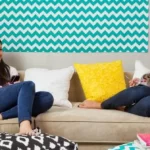The Best Fluffy Pancakes recipe you will fall in love with. Full of tips and tricks to help you make the best pancakes.
Dorm Room Accessibility: Creating An Inclusive Living Space

Are you a college student living in a dorm? Are you looking for ways to make your living space more accessible for students with disabilities? If so, this blog post is for you. We’ll discuss how to create an inclusive dorm room and the best accessibility features to look for when shopping for furniture and appliances.
Introduction to Accessibility and Inclusion
Introduction to Accessibility and Inclusion: Accessibility and inclusion are key factors in creating a safe and comfortable living environment for everyone. The Americans with Disabilities Act (ADA) sets the standard for accessible housing, while the Fair Housing Act regulates requirements for accessible parking and public spaces. Universal design focuses on designing an environment that works for people of all abilities, and visitability encourages interaction through accessibility. Mason’s Housing Request Committee assists students with disabilities in finding the right accommodations to meet their needs. To ensure a safe and accessible route to building entrances, Mason also has systems in place to make public and common use areas usable. By creating an inclusive living space, we can ensure equal opportunities for everyone.
Universal Design: Creating an Environment for Everyone
Universal Design is an important factor in creating an inclusive living space, as it allows for people of all ages and abilities to access and use public and private spaces. The concept of universal design calls for structures and environments to be designed in such a way that they are easy for everyone to use and understand. Incorporating universal design into dorm rooms can help make them accessible, comfortable, and inviting for all students. Additionally, visitability techniques can help increase interaction between students by making it easier for them to move around the dorms. Requirements for accessible housing also need to be taken into consideration, as well as reasonable accommodations for independent living, ADA compliant rooms, the Fair Housing Act and accessible parking. Furthermore, universities like Mason should have an accessible route to their building entrance, as well as usable public and common use areas.
Visitability: Increasing Interaction through Accessibility
Visitability is an effective way to increase interaction and create an inclusive living space. Through this approach, multi-bedroom housing units containing accessible sleeping rooms with mobility features are designed with an accessible route throughout the unit. It also supports neighborliness by providing a zero-step front entry, enabling people with disabilities to access the housing unit. Additionally, the Fair Housing Act Amendments (1988) and the Americans with Disabilities Act (ADA) require that all newly built homes and housing must be made accessible. Reasonable accommodations are also provided to allow for independent living. Finally, universities must ensure that their dorms are ADA compliant and have an accessible route to the building entrance, as well as usable public and common use areas. This helps to create a more inclusive environment for everyone.
Requirements for Accessible Housing
Requirements for Accessible Housing include the Architectural Barriers Act (1968), Section 504 of The Rehabilitation Act of 1973, the Fair Housing Act, and ADA Standards set by the Access Board. A wheelchair user may require specific housing accommodations such as an ADA compliant room, a centralized location, a lower bed, or an accessible route to the building entrance. K strives to make positive and inclusive housing arrangements for all students, which may require physical changes to room/building/technology. To ensure a welcoming and accessible living environment for everyone, it is important to adhere to pervasive design requirements that create an environment for everyone.
Reasonable Accommodations for Independent Living
Reasonable Accommodations for Independent Living enable individuals with disabilities to live independently, and access housing without any hindrance. These may include structural changes like moving a classroom to the first floor, or programmatic modifications such as providing an ADA compliant room, centralized location, or even an accessible route to the building entrance. The Fair Housing Act and other relevant federal laws ensure that individuals with disabilities have the right to make requests for reasonable accommodations. Additionally, Student Accessibility Services, Residence Life, and Physical Plant work together to ensure that students have equal access to residence halls and other facilities on campus. By creating an environment that is welcoming and accessible to everyone, we can ensure that everyone has the opportunity to live independently and access housing without any hindrance.
ADA Compliant Rooms
Dorm Room Accessibility: Creating An Inclusive Living Space
Under the Fair Housing Act and ADA, requirements must be met for an accessible housing environment. Building owners must meet ADA apartment requirements and Fair Housing Act accessibility standards with adaptable dwelling units and compliant public areas. This includes all common use spaces and a prescribed number of units that must be mobility accessible (ADA-224). Additionally, the 2010 Standards set minimum requirements – both scoping and technical – for newly designed and constructed or altered State and local programs to an accessible location, or by making the ADA and the Fair Housing Act appear on means interior or exterior rooms or spaces of a building. Furthermore, the ADA does not apply to individually owned or leased housing in the private sector not used as a public accommodation, including single family homes. As such, it is important for colleges and universities to consider Equity and Access when creating their on campus environment as well as provide reasonable accommodations or inclusive spaces to ensure accessibility in all dorms.
The Fair Housing Act and Accessible Parking
The Fair Housing Act and Accessible Parking further ensures that individuals with disabilities have the same access to housing as those without. This includes making sure that parking lots are designed in such a way as to provide access for disabled individuals, either through wider spaces or by creating designated accessible spaces. The U.S. Department of Justice issued updated regulations under the Americans with Disabilities Act (ADA) in 2010, which addressed parking access aisles and other improved areas that must be taken into consideration. Furthermore, all leasing agreements should address disability access issues, including facility renovations and maintenance, to ensure all individuals have an equal opportunity to enjoy their living space.
The Housing Request Committee at Mason
At George Mason University, the Housing Request Committee is committed to creating a welcoming and inclusive ecosystem for all students. The committee is made up of staff from Disability Services, Student Health Services, and Housing and Residence Life. These three groups work together to evaluate requests for housing accommodations due to medical, psychological, or disability conditions. The committee also consults with the Campus Accessibility Education group to ensure that the housing environment is accessible and provides reasonable accommodations for independent living. Furthermore, the university has implemented universal design principles to create an environment where everyone can feel welcome and included. This includes providing accessible routes to building entrances, usable public and common use areas, and accessible parking in accordance with the Fair Housing Act.
Accessible Route to Building Entrance
The accessible route to the building entrance is a key element for creating an inclusive living space and is essential for ensuring accessibility for all. The Americans with Disabilities Act Title III (2010 ADA Accessibility Guidelines) states that an accessible path of travel should consist of walks and sidewalks, curb ramps and other interior or exterior pedestrian ramps, clear f



